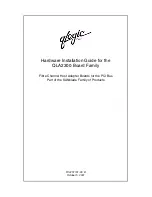
Configuration Option Tables
A-18
7110-A2-GB20-00
June 1997
Table A-7.
External Device Options (3 of 3)
Escape Sequence Delay (sec)
Possible Settings: None, 0.2, 0.4, 0.6, 0.8, 1.0
Default Setting: None
Amount of delay before sending the first character of the escape sequence and after
sending the last character. The escape sequence is entered in the previous option.
During this delay, no data is sent out the Management port.
Escape Sequence Delay (sec) option appears when External Device Commands
is set to Other.
None – No Management port escape sequence delay.
0.2 to 1.0 – Amount of delay in seconds before and after an escape sequence. The
delay must be equal to or greater than the escape guard time of the external device.
Disconnect String
Possible Settings: ASCII Text, Clear
Default Setting: [blank]
The Disconnect String specifies the command used to disconnect an external device.
The external device must be in command mode, so the Escape Sequence is always
sent before the Disconnect String.
Disconnect String option appears when External Device Commands is set to
Other.
ASCII Text – Enter a maximum of 20 characters. Refer to the
ASCII Characters
section
for valid ASCII characters and control sequences.
Clear – Clears the field and sets to no string. The Management port DSR lead is used
to force a disconnect.
Telnet Session Options
To access the Telnet Session Options screen, follow this menu selection
sequence:
Main Menu
→
Configuration
→
Load Configuration From
→
User Interface
→
Telnet Session
Table A-8.
Telnet Session Options (1 of 2)
Telnet Session
Possible Settings: Enable, Disable
Default Setting: Disable
Specifies if the DSU/CSU will respond to a Telnet session request from a Telnet client
on an interconnected IP network.
Enable – Allows Telnet sessions between the unit and a Telnet client.
Disable – No Telnet sessions allowed.
















































